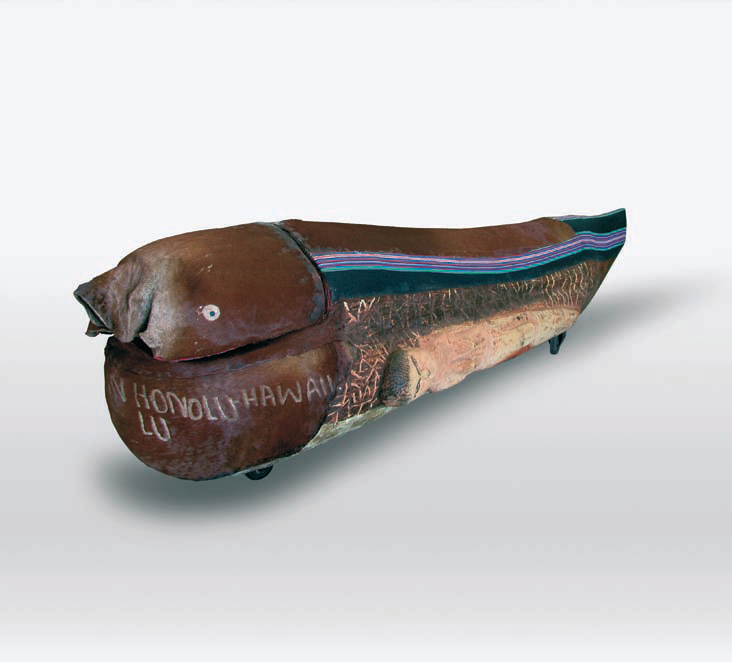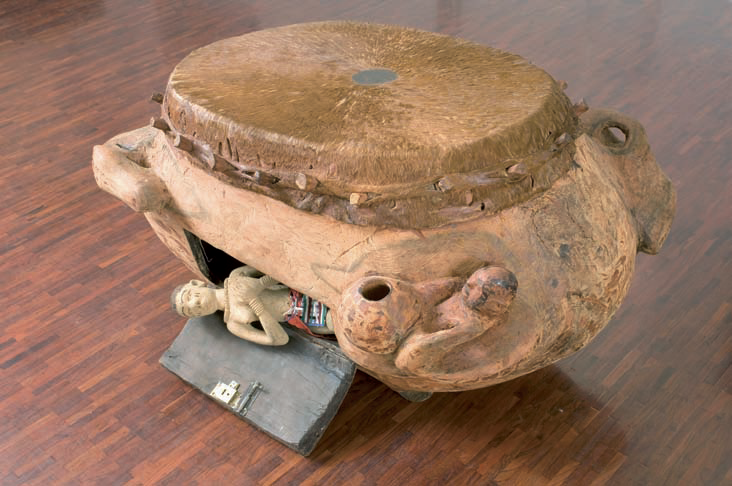In 1996 Samson Mudzunga added the element of performance to his earlier woodcarving and drum-making production. The South African media and the mainstream art community found the combination of his traditional skills and ritual with his newly staged performances electric.
His first performances were inextricably linked and site specific to the geographical area in northern Venda, between his home in Shanzha and nearby Lake Fundudzi. Although his later performances were conceived with direct intervention from the art world and have taken place as part of international art exhibitions, his earlier performances were completely linked to a Venda rite of passage: birth, marriage, or death. For most of his performances Mudzunga makes a large drum, which is to be played (from both inside and out). The drum is the central element, housing his reclining body, as a corpse in a coffin, for instance, in a staged burial and rebirth.
Mudzunga’s performances have not been without tension. The artist deliberately courted controversy as an integral element of his work. In the first burial performance that took place in Shanzha and Lake Fundudzi in 1996, Mudzunga openly transgressed the laws of Venda society, which hold that the chief rules supreme and that certain rituals attached to chieftainship are enacted solely at the chief’s dictate. Mudzunga flouted this law by employing large groups of musicians and dancers to accompany his performance. When his procession attempted to access the sacred Lake Fundudzi, the road was blocked by the local headman.
In his 1997 wedding performance, he created an “Aeroplane Drum” to house his new fourth wife, and all four wives were contained in the drum at one stage. Mudzunga says that he put wings on the drum so he could fly away from South Africa, and in fact, this was the drum Mudzunga selected to be taken to the Museum Bochum in Germany, for an exhibition and performance in the show New Identities in 2004.
In 2000 Mudzunga was imprisoned, accused of burning part of the headman’s property. Mudzunga was released on bail, but two days before a planned performance he was rearrested when accused of plotting the headman’s murder.
Several months later he was released again, and symbolically “reburied” his mother, who had died while he was in jail. In this performance he risked being possessed by the malevolent zidudwane, or water zombies, who inhabit Lake Fundudzi, by openly by drinking the sacred waters. The lake is considered to be the symbolic womb of the Venda people.
Once admittedly unaware of how the art world would ever find his performances “contemporary,” Mudzunga has found a winning formula to fulfill his self-proclaimed and now self-fulfilled dream of becoming famous, and he now exhibits in such countries as the United States, Germany, and Austria.

Fundudzi in Honolulu, Hawaii 2006
Wood, cowhide, fabric, paint, polish, wheels, photograph
331 x 63 x 82 cm
Image courtesy of the artist and Michael Stevenson Gallery
Photographer: Mario Todeschini
© Samson Mudzunga

Suka Africa Fundudzi 2004
Performance with drum: wood, enamel paint, animal hide
The Nave, Cathedral of St. John the Divine, New York, 23 September 2004
Commissioned by Season South Africa for Personal Affects
Image courtesy of the artist and the Michael Stevenson Gallery
Photographer: Mario Todeschini
© Samson Mudzunga

Coffin Drum 1995
Wood, animal skin, lock, key, textile
72.5 x 120.5 x 98 cm
Collection: Standard Bank African
Art Collection (Wits Art Galleries)
Image courtesy of the artist and the Michael Stevenson Gallery, Cape Town
Photographer: John Hodgkiss
© Samson Mudzunga